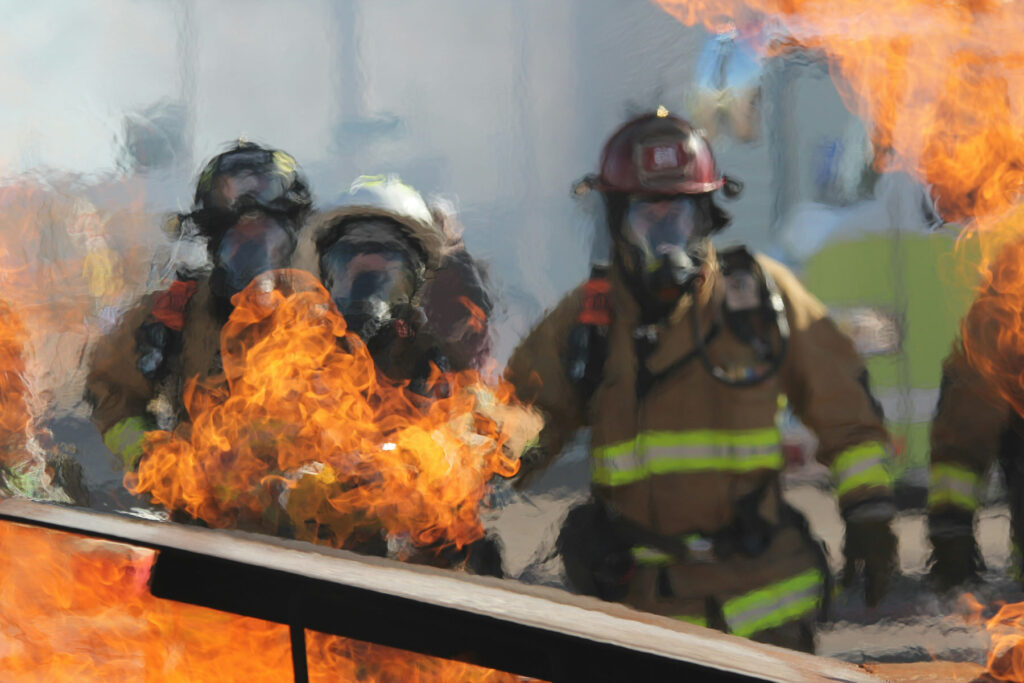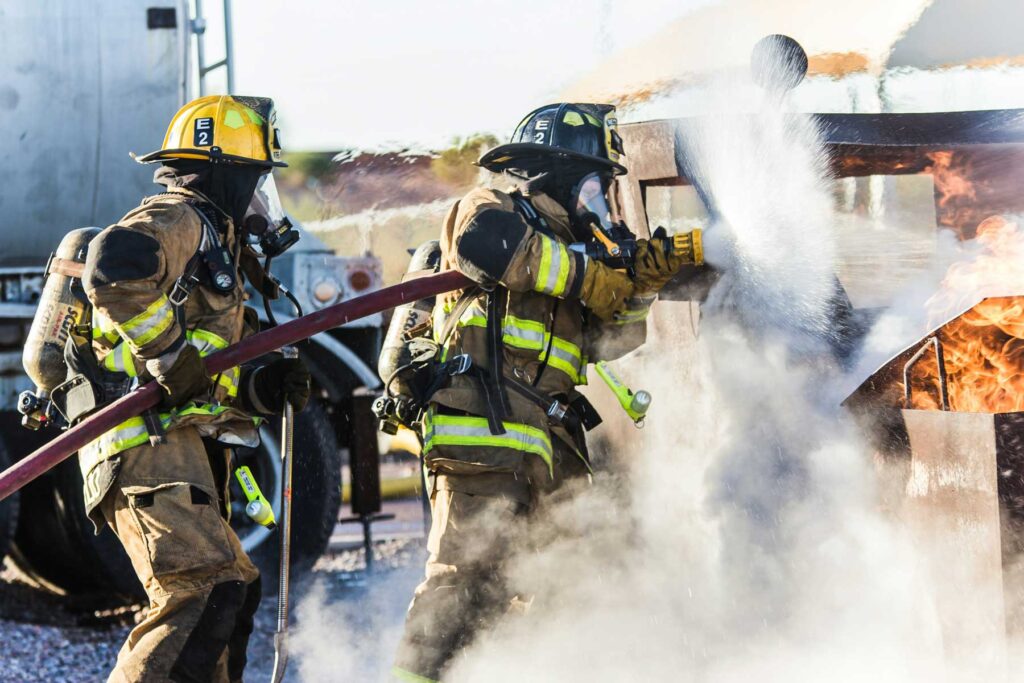Compressed Air Foam: The Solution for Modern Fires
By Jerry Hughes
Modern homes burn faster and hotter than those built decades ago, largely due to synthetic, petroleum-based materials. Traditional firefighting methods often struggle against these new fire loads. That’s why compressed air foam is becoming a critical tool for today’s fire departments. Unlike plain water, compressed air foam systems (CAFS) deliver faster suppression, better surface coverage, and greater efficiency, offering a powerful advantage in battling today’s synthetic-fueled fires.
Chemistry’s Double-Edged Sword: Why Compressed Air Foam is Needed
Advances in chemistry have brought durable, water-resistant materials into our daily lives, but at a cost. Compared to natural fibers like wood and cotton, synthetic polymers ignite faster, burn hotter, and resist water-based extinguishment. Items ranging from children’s toys to kitchen utensils contribute to hotter, deadlier fires.
The National Fire Protection Association (NFPA) reports that kitchens remain the leading site of residential fires, and smoke inhalation is the top cause of fire-related deaths. Homes built decades ago gave occupants about 29 minutes to escape a fire—today, that window has shrunk to just three minutes. Fires now burn faster, hotter, and more aggressively, making fast, effective suppression critical.
Water vs. Compressed Air Foam in Firefighting
Traditional firefighting relies on water to absorb heat and cool flames. However, water’s effectiveness diminishes against synthetic fuels. The steam generated becomes diluted with flammable gases, complicating suppression efforts and making water streams highly inefficient.
Studies by UL’s Fire Safety Research Institute show that in fires fueled by synthetics, only 5–10% of water stream application is effective at actual fire suppression. The rest becomes runoff.
To fight these fires effectively, departments are increasingly turning to compressed air foam systems (CAFS), which enhance water’s effectiveness dramatically.
Choosing the Right Flow Formula
Two main formulas guide water flow rates in firefighting:
- Iowa Rate-of-Flow Formula: Emphasizes gallons per second (GPS) based on total building square footage.
- National Fire Academy (NFA) Formula: Adjusts water application based on the percentage of the structure actively burning.
Personally, I prefer the Iowa formula for its aggressive, gallon-per-second focus on fire attack. A typical residential attack flowing 150 GPM equals about 2.5 gallons per second. Yet due to water’s inefficiency on synthetic fuels, achieving a full effective gallon per second would require 600 GPM—a logistical challenge for many departments.
This is where compressed air foam bridges the gap.
How Compressed Air Foam Systems (CAFS) Work
Compressed air foam systems combine three elements:
- Water
- Foam concentrate
- Compressed air
The system injects compressed air into the water/foam mix inside the hose, generating high-energy, durable bubbles before the mixture even reaches the nozzle. This internal energy differs from Nozzle Aspirated Foam Systems (NAFS), where ambient air is drawn in externally, creating weaker, fragile bubbles.
Compressed air foam is typically 99% water and 1% Class A foam concentrate, yet it dramatically boosts stream reach, adhesion to burning surfaces, and suppression power—making it ideal for today’s fires.
Three Types of Compressed Air Foam:
| Type | Expansion Ratio | Best Use |
| Low Expansion | 2:1 to 10:1 | Wet foam for initial attacks |
| Medium Expansion | 10:1 to 20:1 | Protective blanket against radiant heat |
| High Expansion | 20:1 to 200:1 | Filling large spaces like hangars |
Advantages of Compressed Air Foam Over Water
- Higher Efficiency: CAFS increases water’s surface area and penetration, extinguishing fires faster with less water.
- Longer Reach: CAFS streams reach farther than water-only streams, giving firefighters a safer distance.
- Clings to Surfaces: Foam sticks to burning materials, preventing re-ignition.
- Reduces Water Damage: Less runoff means reduced property damage after the fire is out.
- Better Protection: Medium and high expansion foams offer thermal insulation against radiant heat.
In short, compressed air foam makes every gallon count.
3:1 Compressed Air Foam FormulaPump operators maintain a ratio of 3 parts air measured in cubic feet per minute (CFM) to 1 part water measured in gallons per minute (GPM) in solution with foam concentrate to make CAFs. Never restrict CFM (air volume). Adjust air pressure to match pump pressure. Increase water flow (gpm) to make wet foam or decrease water flow to make dry foam. Example:
Step-by-step: 1. Convert Cubic Feet of Air (per minute) CFM to GAPM (gallons air per minute): GAPM = 150 CFM × 7.48 = 1122 GAPM 2. Calculate GPMF (gallons per minute foam): GPMF = 1122 GAPM + 50 GPM = 1172 GPMF[1] 3. Convert GPMF to GPSF (gallons per second foam): 1172 GPMF ÷ 60 seconds = 19.53 ≈ 20 GPSF 4. Determine the Expansion Ratio: Gallons of Finished Foam ÷ Gallons of Water ©2025 Gerald L. Hughes. All rights reserved. |
Compressed Air Foam: The Future of Firefighting
Traditional water streams alone aren’t enough as modern fires grow hotter and faster. Compressed air foam systems (CAFS) provide the superior suppression power for today’s synthetic-fueled environments. By expanding water’s reach, improving surface contact, and reducing runoff, CAFS saves lives, protects property, and makes firefighting safer for everyone involved.
In today’s firefighting world, compressed air foam isn’t just an innovation; it’s a necessity.
[1] Converting cubic feet of air to gallons of air allows pump operators to add gallons of air to gallons of water to determine gallons per minute of finished foam (GPMF).
Jerry Hughes
Chief Consultant
Fire Consulting Services LLC
https://fireconsultingservicesllc.com/
Jerry Hughes, retired Chicago Fire Department Battalion Chief, served the Chicago Fire Department 35+ years in the rank of Firefighter, Engineer, Company Officer, and Battalion Chief and is dedicated to spreading the word about evidence-based advancements in Firefighting. He has authored training on firefighting foam through Fire Rescue 1 Academy, which is currently used in 26 States. Chief Hughes has also been published in Fire Engineering Magazine and Fire Chief Magazine on topics related to fire prevention and fire operations. He is a Certified EMT-B, Hazardous Materials Tech and has received Certification in Compressed Air Foam Systems through the Illinois Fire Service Institute.


